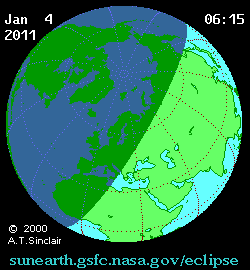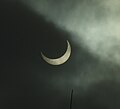Solar eclipse of January 4th, 2011
| Solar eclipse of January 4th, 2011 | |
|---|---|
 Course of the penumbra on the earth's surface, time of the animation in Universal Time |
|
| classification | |
| Type | Partially |
| area | Africa , Europe , Central Asia |
| Saros cycle | 151 (14 of 72) |
| Gamma value | 1.0626 |
| Greatest eclipse | |
| place | Gulf of Bothnia |
| location | 64 ° 41 ′ N , 20 ° 54 ′ E |
| time | January 4, 2011 8:50:35 UT |
| size | 0.8576 |
The solar eclipse of January 4, 2011 was the 14th of 72 solar eclipses in the Saros cycle number 151.
This eclipse was partially because the earth only by partial shade was made of the moon. There was therefore no place on earth from which the sun could be seen completely covered. The coverage of the sun was 86% at Skelleftea in Sweden ( latitude 64 ° 40 ') at the largest, that is just south of the Arctic Circle and the former border of the polar night . The values for Germany were 75% in the southwest and 82% in the northeast. The eclipse was visible successively between northwestern Africa (sunrise), Central Europe (morning; the sun had already risen overcast), Scandinavia (morning) and Inner Asia (sunset). Due to the proximity of the winter solstice , the moon's penumbra fell close to the equator .

Photo montage: below the sun, which was already slightly overcast at sunrise; in the second picture from the top the view around the time of the middle of the eclipse
There were three more partial solar eclipses in 2011: June 1st, July 1st, and November 25th. Like all partial eclipses, they have their maximum coverage in a polar region. In the eclipse of June 1st, it is on the Arctic Ocean coast east of Murmansk , when the midnight sun is only shining just above the northern horizon. The visibility area extends over the North Pole to its southern border, which runs from northern Japan through Alaska and northern Canada to Newfoundland . Because of the proximity to the summer solstice , the moon's penumbra remains far away from the equator.
The next eclipse on July 1st will take place on the following new moon, this is the shortest possible time interval between two solar eclipses. Two such solar eclipses in direct succession are the "ideal framework" for a lunar eclipse of high totality. One of these will take place on June 15, 2011 with a total of 100 minutes. In Central Europe, the moon rises darkly, the totality cannot be fully observed here.
Subsequent solar eclipses are those of May 20, 2012 ( annular , East Asia , North Pacific and North America ) and November 13, 2012 ( total , extreme northeast of Australia and South Pacific). The next eclipse to be seen in Europe will take place as total eclipse on March 20, 2015 . Its central line (total eclipse of the sun) runs over the North Atlantic and the North Sea , where it meets the Faroe Islands and Svalbard . In the rest of Europe only the partially covered sun can be seen.
gallery
literature
- HU Keller: Kosmos Himmelsjahr 2011: Sun, moon and stars over the course of the year. Pp. 12-16, ISBN 3-440-12365-0
- Solar eclipse: The natural spectacle remains mainly behind clouds. In: Aargauer Zeitung from January 4, 2011
- Solar eclipse: A clear view of "rarity" In: ORF.at from January 4, 2011





